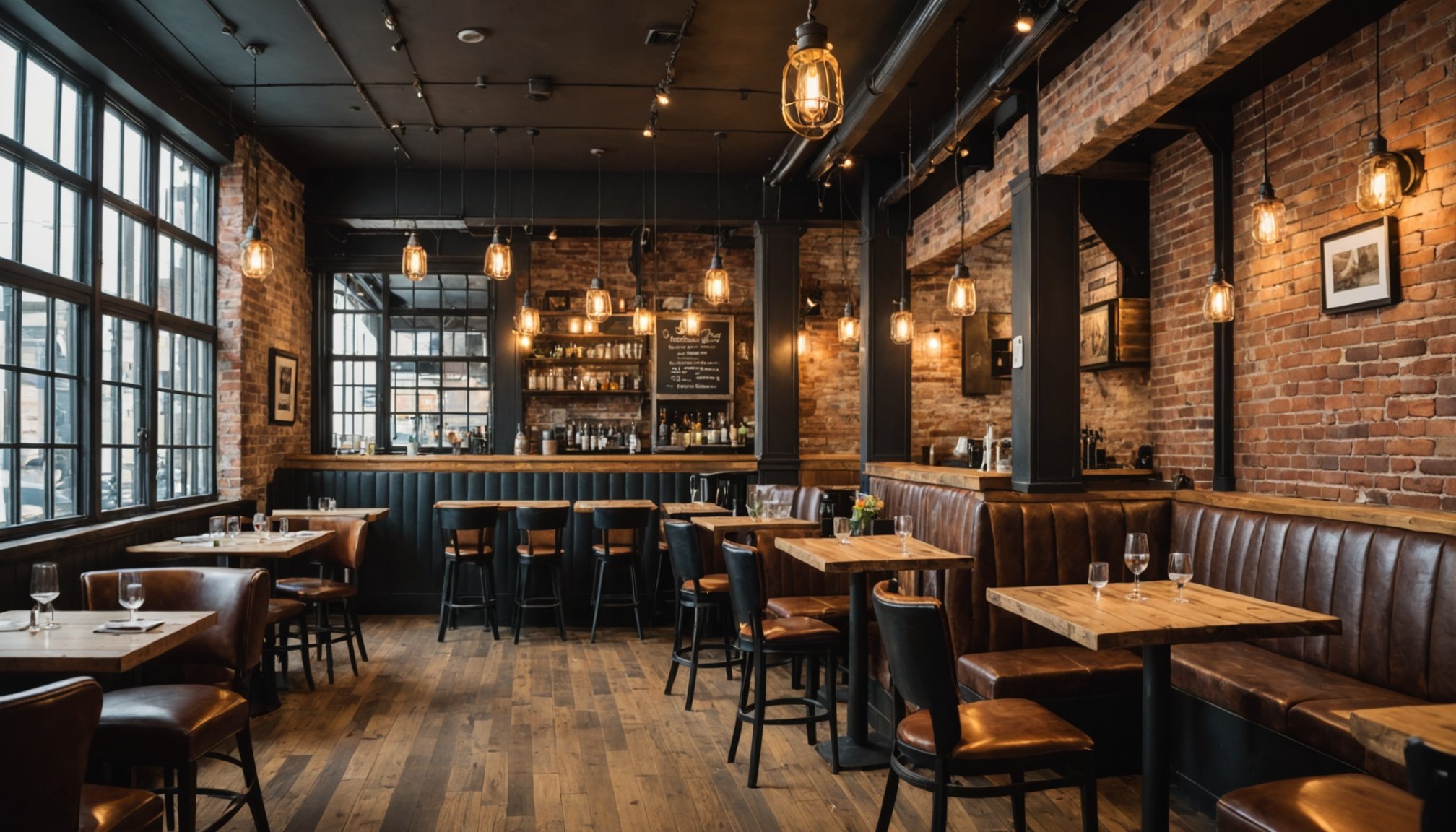Transforming your restaurant’s interior can significantly enhance its atmosphere and appeal. Using reclaimed materials not only brings a unique aesthetic but also showcases sustainability, appealing to eco-conscious diners. These materials tell stories, connecting patrons to the past while promoting a modern ethos. From reclaimed wood tables to vintage light fixtures, each element can create a memorable dining experience. Discover how to incorporate these elements to elevate your space and resonate with today's environmentally aware clientele.
Advantages of Reclaimed Materials in Restaurant Design
Incorporating reclaimed materials into restaurant design offers numerous benefits, particularly in terms of sustainability and environmental impact. By reusing materials, restaurants can significantly reduce their carbon footprint. This approach minimizes waste and conserves natural resources, aligning with eco-friendly practices that are increasingly valued by consumers.
Also read : Essential Factors to Keep in Mind When Crafting a Sustainable Restaurant Design
Beyond sustainability, reclaimed materials provide a distinctive aesthetic appeal. Each piece carries a unique history, adding character and authenticity to the space. This can create a warm and inviting atmosphere, which is particularly appealing in a dining setting. The use of varied textures and finishes can enhance the visual interest of a restaurant, setting it apart from more conventional designs.
From a financial perspective, reclaimed materials can be highly cost-effective. Although the initial sourcing might require some effort, the potential savings are substantial. These materials are often less expensive than new ones, and their durability can lead to long-term cost savings. Additionally, using reclaimed materials can be a marketing advantage, attracting environmentally-conscious customers and enhancing the restaurant's brand image.
This might interest you : Mastering the art of an enticing live cooking station for your buffet restaurant: the definitive guide
In summary, the benefits of reclaimed materials in restaurant design extend beyond just aesthetics. They offer a sustainable, cost-effective solution that enhances the dining experience while supporting environmental conservation efforts.
Case Studies of Successful Implementations
Exploring restaurant design case studies reveals innovative uses of reclaimed materials that have achieved both aesthetic and functional success. One notable example is the acclaimed restaurant Noma in Copenhagen. Known for its commitment to sustainability, Noma incorporates reclaimed wood and metal into its interior design. These materials not only enhance the rustic charm of the space but also align with the restaurant's ethos of environmental responsibility.
Another example is the Chicago-based eatery, The Publican, which utilizes reclaimed barn wood and vintage light fixtures. This choice creates a warm, inviting atmosphere that resonates with patrons, reinforcing the restaurant's farm-to-table philosophy. The design choices have resulted in high customer engagement, as diners often express appreciation for the restaurant's authentic and cozy ambiance.
Customer feedback in these case studies highlights a growing trend: diners are increasingly valuing sustainability and authenticity in their dining experiences. Many patrons report feeling a deeper connection to the space, knowing that the materials have a story and contribute to a broader environmental cause. This engagement not only benefits the restaurant's brand image but also fosters a loyal customer base that appreciates the thoughtful integration of reclaimed materials in restaurant design.
Practical Tips for Sourcing Reclaimed Materials
When it comes to sourcing reclaimed materials for restaurant design, knowing where to look is crucial. Salvage yards and architectural salvage stores are excellent starting points. These locations often house a diverse range of materials, from reclaimed wood to vintage fixtures, that can add character to your restaurant.
Evaluating the quality and authenticity of reclaimed materials is essential. Inspect items for structural integrity and signs of wear that could affect their longevity. Authenticity can be gauged by the material's provenance; understanding its history can ensure it aligns with your design ethos.
Negotiating effectively can lead to significant cost savings. When purchasing reclaimed materials, consider these tips:
- Research market prices: Familiarise yourself with typical costs to ensure you’re getting a fair deal.
- Bundle purchases: Buying in bulk can often lead to discounts.
- Build relationships: Establish a rapport with sellers, which can lead to better deals and early access to new stock.
By following these strategies, you can source high-quality, authentic materials that not only enhance your restaurant's design but also support sustainability efforts. These steps ensure that reclaimed materials contribute positively to both the aesthetic and environmental goals of your project.
Aesthetic Benefits of Reclaimed Materials
Incorporating reclaimed materials into restaurant design offers significant aesthetic advantages, elevating the overall ambiance and charm of the space. These materials inherently possess a unique blend of textures and colors that can transform a restaurant's interior into a visually captivating environment.
Reclaimed materials often feature natural, weathered finishes that contribute to a rustic and authentic aesthetic. This can be particularly appealing in creating a warm and inviting atmosphere, which is crucial in enhancing the dining experience. The varied color schemes found in reclaimed wood, metal, and stone can add depth and visual interest, setting a restaurant apart from more conventional designs.
Moreover, the use of reclaimed materials allows for the creation of a cohesive design theme. By selecting materials with complementary textures and tones, designers can craft a unified look that ties the entire space together. This approach not only highlights the uniqueness of each material but also ensures that the design remains harmonious and balanced.
The aesthetic design benefits of using reclaimed materials are undeniable; they provide an opportunity to craft a distinct and memorable dining environment. This approach not only enhances the visual appeal but also aligns with the growing consumer appreciation for sustainability and authenticity in design.
Cost Savings from Using Reclaimed Materials
Incorporating reclaimed materials into restaurant design can be a highly cost-effective design solution. When comparing the costs of reclaimed versus new materials, reclaimed options often come out ahead. They are generally less expensive than new materials, offering an immediate reduction in initial expenses. This cost advantage is particularly appealing for budget-conscious projects aiming to achieve a unique aesthetic without overspending.
Beyond initial savings, reclaimed materials also contribute to long-term financial benefits. Their inherent durability often translates to reduced maintenance and replacement costs over time. This durability ensures that the materials withstand the rigours of a bustling restaurant environment, providing lasting value and reducing the need for frequent repairs or replacements.
Moreover, financial incentives and grants are available for businesses that adopt sustainable practices. Many local and national programs offer support to establishments that integrate eco-friendly materials into their designs. These incentives can further offset costs, making reclaimed materials an even more attractive option for restaurant owners.
By leveraging these opportunities, restaurants can not only enhance their design but also strengthen their financial standing, all while contributing positively to environmental conservation efforts. Embracing reclaimed materials is a strategic move that aligns economic and ecological goals seamlessly.
Environmental Impact of Reclaimed Materials
Incorporating reclaimed materials into restaurant design significantly impacts the environment by reducing waste and lowering carbon footprints. By reusing existing resources, the demand for new production is minimized, leading to a substantial decrease in waste sent to landfills. This practice not only conserves space but also reduces the harmful emissions associated with waste decomposition.
The environmental benefits extend to a reduced carbon footprint. Manufacturing new materials often involves energy-intensive processes that contribute to greenhouse gas emissions. In contrast, using reclaimed materials bypasses these processes, resulting in lower overall emissions. This shift supports global efforts to combat climate change and promotes sustainable development.
Moreover, reclaimed materials can bolster local economies by supporting local craftsmen and businesses. Many reclaimed materials are sourced locally, creating opportunities for artisans and small enterprises specializing in salvaging and repurposing. This not only fosters economic growth within the community but also preserves traditional skills and craftsmanship.
In summary, the environmental impact of using reclaimed materials in restaurant design is profound. By reducing waste, lowering carbon emissions, and supporting local economies, reclaimed materials offer a comprehensive solution to environmental challenges while enhancing the sustainability of restaurant design.
Design Ideas Incorporating Reclaimed Materials
Incorporating reclaimed materials into interior design ideas can transform a restaurant space into a unique and inviting environment. Innovative uses of reclaimed wood, metal, and glass can create stunning focal points and functional elements that captivate diners.
Reclaimed wood can be used to craft eye-catching feature walls or rustic furniture pieces, adding warmth and texture. Metal elements, such as vintage light fixtures or repurposed steel beams, can introduce industrial charm and durability. Glass, salvaged from old windows or bottles, can be transformed into beautiful partitions or decorative accents, enhancing light and transparency in the space.
Combining reclaimed materials with modern elements offers a balanced design approach. For instance, pairing reclaimed wood with sleek metal furniture can create an intriguing contrast, blending rustic and contemporary styles seamlessly. This fusion of materials can result in a cohesive and harmonious interior that appeals to a wide range of tastes.
Design ideas can also be inspired by seasonal and thematic concepts. For example, incorporating reclaimed materials with seasonal decor, such as autumnal colours or winter textures, can create a dynamic and ever-evolving atmosphere. Thematic designs, like nautical or vintage-inspired spaces, can be enriched with reclaimed elements, adding depth and authenticity to the overall aesthetic.
Installation Process for Reclaimed Materials
Navigating the installation of reclaimed materials in restaurant design requires careful planning and execution. Best practices vary depending on the material type, but generally, it's crucial to assess the condition and structural integrity of each piece before installation. For reclaimed wood, ensure it is properly treated to prevent pests and rot. Metal elements should be inspected for rust and stabilized if necessary.
When considering the installation approach, the choice between hiring professionals and opting for a DIY method depends on the complexity of the project and your expertise level. Professional installers bring experience and can ensure that reclaimed materials are integrated safely and effectively, especially for intricate designs or structural elements. However, for simpler projects, a DIY approach can be rewarding and cost-effective, provided you have the necessary skills and tools.
Safety and durability are paramount in installations. Ensure all materials are securely fastened and compliant with local building codes. For durability, consider the environment in which the materials will be used; high-traffic areas may require additional reinforcement. Proper sealing and finishing can also enhance longevity and maintain the aesthetic appeal of reclaimed materials, ensuring they withstand the test of time in a bustling restaurant setting.











